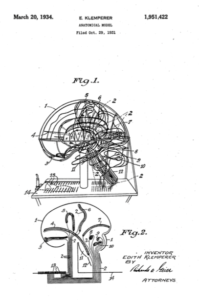
HIGHLIGHTS
In 1934, Dr. Edith Klemperer of Vienna patented her Luminous Brain Model, an anatomical model of the brain made from glass tubes that would light up many colors.
Dr. Edith Klemperer was one of the first women to practice neurology and psychiatry and is known for having invented her educational “Luminous Brain” and her pioneering work in the field of hypnotherapy.
Born and educated in Vienna, Dr. Klemperer earned her medical degree in 1923 from the University of Vienna. While still in Austria, she invented the “Luminous Brain,” an educational model used for teaching and understanding brain function using lights and color to demonstrate the brain’s electrical impulses. The Luminous Brain could demonstrate neural pathways showing thoughts, automatic movements (such as breathing), and disordered neural impulses associated with mental illnesses. Dr. Klemperer first demonstrated her model at the First International Neurological Congress in Bern, Switzerland, in September 1931 and again at the 95th Annual Meeting of the American Psychiatric Association in Chicago in May 1939. In 1934, the United States Patent Office granted Dr. Klemperer a patent on her Anatomical Model.
During her time in Vienna, Dr. Klemperer also researched and published on a variety of topics, including the chemical analyses of blood, urine, and cerebrospinal fluid samples in a variety of psychiatric and brain disorders; the use of insulin in the management of delirium tremens (the psychotic syndrome developed by the body in response to alcohol withdrawal); the body’s reaction to hypnosis; and Korsakoff syndrome (a memory disorder resulting from B1 deficiency) in response to insulin treatment in diabetics. Dr. Klemperer’s pioneering work on blood tests showed a connection between psychic emotions and chemical changes in the blood.
Of Jewish descent, Dr. Klemperer fled Austria after it fell under Nazi control. She moved to New York in September 1939 and continued her work in neurology and psychiatry. Most of her work in the US was focused on the emerging fields of hypnosis, hypnotherapy, and hypnoanalysis. Between 1954 and 1969, Dr. Klemperer lectured at the Society for Clinical and Experimental Hypnosis and published several papers in the Journal of Clinical and Experimental Hypnosis, including on such topics as technique, past ego emerging states, projective phenomena, primary-object relationships, spontaneous self-portrait, and changes in body image. Dr. Klemperer also studied hypnosis’s use in helping people to quit smoking tobacco and lectured on alcoholism at the 1964 Annual Conference of the New York Chapter of the American Society of Group Psychotherapy.
Author: Alexandra J. Olson, Carlson Caspers partner
To learn more about Carlson Caspers’ commitment to Diversity & Inclusion, click here.
To apply for the Carlson Caspers Diversity & Inclusion Scholarship and meet past recipients, click here.
To learn about Carlson Caspers’ engagements with organizations committed to diversity and inclusion in the legal profession, click here.
To learn about other featured inventors, click here.
